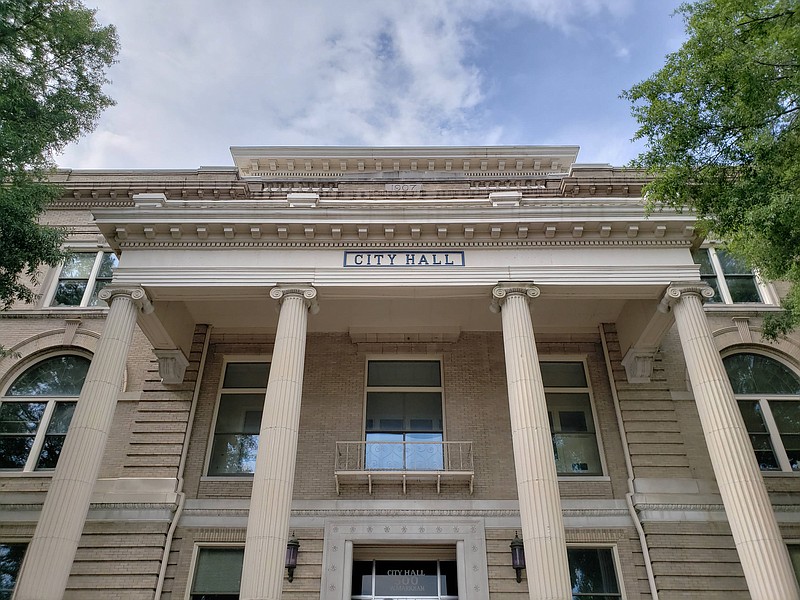At the request of Little Rock Mayor Frank Scott Jr., leaders of city departments have submitted recommendations for how the city ought to use the first half of $37.7 million on its way as a result of the American Rescue Plan Act.
Nearly $19 million was received in May. The second tranche is expected to be sent a year from now, according to the U.S. Treasury Department.
According to correspondence records obtained through an Arkansas Freedom of Information Act request, the spending suggestions included more body-worn cameras for police, a storm-water-runoff project at the Little Rock Zoo and the addition of 50 patrol vehicles to the police fleet.
It's unclear if the city will be able to fulfill any of the requests.
During a presentation last month to members of the Board of Directors, the city's director of strategic operations, Emily Jordan Cox, told them that the guidelines for the money have not been finalized.
[CORONAVIRUS: Click here for our complete coverage » arkansasonline.com/coronavirus]
She warned that the federal government would recoup any improperly spent funds and said the Arkansas Municipal League has advised governments not to spend the money yet.
The Treasury Department has outlined five categories for which the aid can be used: underwriting public-health expenditures related to the coronavirus pandemic; providing premium pay for essential workers; funding water, sewer and broadband infrastructure projects; replacing lost government revenue tied to government services; and relieving economic stress caused by the pandemic.
In an email last month to Cox and the mayor's chief of staff, Charles Blake, zoo Director Susan Altrui informed them of two projects that fit the category of infrastructure investments.
She recommended upgrading the broadband infrastructure of the zoo's public Wi-Fi system for $300,000.
A second recommendation was to improve the zoo's storm-water system, which Altrui described as "aging" and no longer able to handle the large volume of rain and runoff. The project was estimated at $1 million to $2 million, or $4 million for an alternative zero-emissions solution, she said.
Altrui also proposed carrying out deferred repairs for $250,000 under the auspices of a federal category allowing governments facing budget shortfalls to use the stimulus money to avoid cuts to government services.
Recommendations submitted by Police Chief Keith Humphrey included a long list of technology upgrades.
Among them were additional licenses for a virtual academy program used for training and evaluation of new officers and sergeants ($8,000); a more advanced deescalation simulator with several screens to give a 360-degree view of scenarios ($50,000); 10 additional license-plate-reading cameras ($80,000); and 65 to 275 WatchGuard body-worn cameras to add to the stock of 326 ($138,385-$585,475).
Willie Hinton, the director of the city's Fleet Services Department, in a memo last month recommended expanding the police patrol fleet by 50 "in order to avoid sharing patrol assets; hence, mitigating transmissions to follow on shifts. This will create a single use fleet."
The price was $2.5 million, he said.
Hinton also asked for the city to add one unit to the Fire Department's aerial fleet "to sharpen pandemic responses." The price was $1.6 million, he wrote. He also recommended building expansions and renovations estimated at $2.5 million.
Jay Barth, the city's chief education officer, informed Blake, Cox and finance director Sara Lenehan that the primary need that could be met with the funding was broadband access.
"We are in the initial stages of a conversation with a provider that covers a community school attendance zone to create sustainable, affordable broadband service at residences across the zone through a City/provider partnership," Barth wrote. "As we are still collecting and analyzing key data, we are not yet far enough along in the planning to have a cost estimate for that promising project."
Although he said he was not prepared to make a request on broadband using the first half of the American Rescue Plan money, "it would be incredibly helpful in that work [if] there was a commitment for a portion of the second tranche of funds (up to $1 million) to go towards such a broadband initiative," Barth wrote in an email.
He recommended allocating $250,000 each for two community centers to convert them into "opportunity centers."
Barth described these sites as potential hubs for out-of-school learning opportunities like tutoring, behavioral health services as well as enrichment activities for families such as digital-literacy training and English-language learning programs.
"Because of its location next door to Stephens Elementary (a community school), I would place first priority on Stephens Community Center," Barth wrote. "The second priority would be for the Southwest Community Center because of its proximity to Watson and Chicot Elementaries."
Additionally, Barth recommended spending $50,000 per year to stock school-based food pantries over the next two years, dividing the resources across schools.
CORRECTION: Little Rock’s director of strategic operations, Emily Jordan Cox, was addressing members of the Little Rock Board of Directors when she told them guidelines for how to spend federal aid to the city have not been finalized. An earlier version of this story incorrectly described the audience for her remarks.
